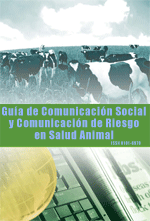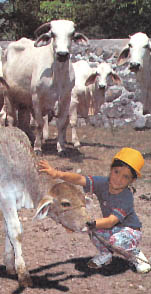Guide for Social Communication and Risk Communication in Animal Health

Full Text (110 pp, PDF, 1 Mb) espaŮol | portuguÍs; chapter headings translated below for user orientation)
1. Introduction
2. Historical Background
3. Social Role of Communication
4. General Principles of Communication
5. Communication for Animal Health
6. Social Communication in the Control of Foot-and-Mouth Disease (FMD)
- Integration and Consciousness-Raising
- FMD and Effective Communication
- Planning and Transparency
- Perception and Reality
- Accuracy and Objectivity
- Language Mechanisms
7. Risk Communication
- Characteristics of a Health Emergency
- The Responsibility of the Media
- The Political Perspective
- Culture of a Participating Citizenry
- Main Objectives
- Challenges and Appropriate Measures
- Strategies for Communicative Actions
- WHO Recommendation
8. Questions and Answers
9. Bibliography

PAHO Links
- Zoonoses/Animal Health
- Veterinary Public Health Unit
- Pan American Foot-and-Mouth Disease Center (PANAFTOSA)
- School of Communications, (ECO), Federal University of Rio de Janeiro (UFRJ)

A complete course in Mass Communications as applied to Animal Health
| Objective: To provide a valuable practical, training, and reference tool in the important area of communications for use by public health officials and animal health services in the countries of "greater MERCOSUR." Applicable in other areas of the Americas and other WHO Regions as a strategic source for facilitating information and knowledge and, as a result, disseminating and harmonizing the methodologies and concepts of Mass Communications for specific application in Veterinary Public Health. |
"Acting in common", as has been shown in the history of the civilizations, is not an easy task to carry out. Communication, in this regard, is one action that should be thought out, planned, evaluated, and re-evaluated as many times as is necessary. Any reflection on the subject should not be dissociated from action, since this would run the risk of barring any truly effective dialog.
This manual, designed in Spanish and Portuguese for use in Latin America, is intended as a guide for effective, real communication that is not dissociated from its social function. It also attempts to fill in gaps in the field of communications in such a way as to strengthen actions taken in the area of animal health and in the control of foot-and-mouth disease:
- The first chapter, the Introduction, provides a basic orientation.
- In the second chapter, the reader receives important background on the bases of modern communication and the roots of communicative action, demonstrating that our actions only become feasible and make sense within the discursive table of communication that encompasses them.
- The third chapter attempts to show in what form organized communication can (and it should) be a valuable aid for public growth and for the establishment of a just and balanced social structure. This guide shows how effective communication considers the public to be both a primary receptor and co-producer of knowledge and its interpretation, and not merely a passive receptor of fragments of information.
- When properly utilized, Mass Communications can become a strategic resource capable of bringing about profound social action over broad areas. This is the subject of the fourth chapter, which deals with the general principles of communication and connects them to the area of
- Communicating for Animal Health—subject studied in depth in the fifth chapter—and its importance for the health workers and local veterinarians.
- The importance of Mass Communications in controlling foot-and-mouth disease (FMD) is the subject of the sixth chapter, which presents a brief panorama of the disease. This is followed by a discussion of what form mass communications can and should contribute to FMD control, and conversely how inadequate communication can result more in exacerbating problems than in finding solutions.
- The seventh chapter, Risk Communication, deals in depth with the effectiveness of communication as well as its possible effects and consequences. It provides examples from past cases and health emergencies where communicative action was effectively put to service in a positive way to educate the public and mobilize society. The chapter provides a direct, objective analysis of the political, epidemiological and media implications, offering an important tool that can be used by the readers in daily practice.
- At the end, in the eighth chapter, a series of questions and answers, encourage the reader to recall and confirm what was covered when reading this manual, as well as to
- continue research by consulting the suggested bibliography in the ninth chapter.
In short, it should be pointed out that this manual was conceived and developed in accordance with a modular structure of several sections with multiple entries. The form proposed here permits to reader to choose the most appropriate entry and level based on their needs at any given time, as well as their requirements and skill level.
This guide offers professionals, technical specialists, and the general public a chance to keep informed in both theoretical and practical terms, clarifying their doubts and enriching their knowledge on the subject. If they so desire, this guide provides them with a complete course in mass communications as it applies to risk situations in Animal Health. We hope that this manual will prove to be of practical, effective, timely, and lasting use.
Happy reading!
- Authors
- Mohammed ElHajji, School of Communications, Federal University of Rio de Janeiro (UFRJ), Rio de Janeiro, Brazil
- Rosane Lopes, Social Communication, Pan American Foot-and-Mouth Disease Center (PANAFTOSA), PAHO/WHO, Rio de Janeiro, Brazil